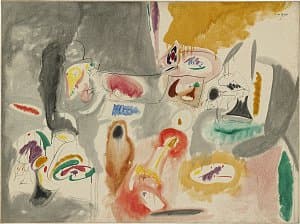

Arshile Gorky
Learn morePlumage landscape 1947
© Arshile Gorky. ADAGP/Copyright Agency Purchased 1973
More detail | PermalinkArshille Gorky’s paintings were invariably preceded by a preliminary drawing. He would select from existing drawings, usually done in the warmer months, to use as the basis for a painting or a number of paintings. The drawing, once transferred to the canvas, served as an armature for his colour. This schema would be interpreted freely and could be worked up in a number of versions, each being a variation on a theme. Two other works completed in 1947 share the same underlying drawing as Plumage landscape: Year after year and Theme for Plumage landscape (call for Virginia).[1]
In Plumage landscape, colour is varied around the common linear structure, thereby allowing individual emphasis and interpretation. The oil paint has been thinned to the consistency of watercolour to produce washes of pure and transparent colour, which preserve the firm black lines of the drawing and maximise the soft organic fluidity of each colour accent. Viridian elements scattered across the picture plane unite the composition. The daring use of tertiary and pastel hues—pinks, ochres, greys—allows the viewer to concentrate on form as well as colour, and emphasises the painting’s high tonality.
Gorky’s titles are usually poetic and evocative rather than descriptive. ‘Plumage landscape’ is a typical creation, conflating the iridescence of birds’ feathers with the idea of moving through a landscape. Ethel Schwabacher, a student of Gorky’s in the mid 1940s, referred to the accents of colour as ‘plumes’ when writing about his work in 1951, and William C Seitz, in a publication of 1962, claimed the term was Gorky’s own.[2] If this is the case, then it may offer some insight into the title of the painting as, literally, a landscape made with aureoles of paint.
Michael Lloyd and Michael Desmond[3]
[1] Respectively, Ex-collection Mr and Mrs Gifford Phillips, New York; and Private collection.
[2] See Ethel Schwabacher’s introduction to Arshile Gorky memorial exhibition, Whitney Museum of American Art, New York, 1951; William C Seitz first claimed that plumes ‘is what Gorky called them’ in the catalogue Arshile Gorky: Paintings, drawings, studies, Museum of Modern Art, New York, Washington Gallery of Modern Art, Washington DC, 1962. This claim reappeared in the text that was reprinted for the catalogue for the exhibition at the Tate Gallery, London, Arshile Gorky: Paintings and drawings, Arts Council, London, 1965. Interestingly, in Seitz’s dissertation of 1955, Abstract Expressionist painting in America, Harvard University Press, Cambridge, Mass., 1983, Seitz attributes the term to Schwabacher.
[3] Adapted and updated from Michael Lloyd and Michael Desmond, European and American Paintings and Sculptures 1870–1970 in the Australian National Gallery, Australian National Gallery Canberra, 1992, p 216, by Christine Dixon.

